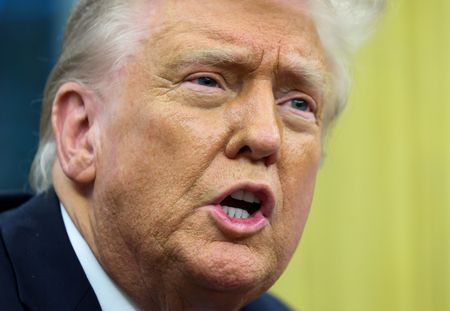By David Morgan
WASHINGTON (Reuters) – Barely a month after predicting a new “golden age” under President Donald Trump, congressional Republicans are struggling to move forward on the president’s tax-cut agenda, despite their control of both the Senate and House of Representatives.
House Republicans on Wednesday unveiled a plan that would cut taxes by about $4.5 trillion over a decade, raise the federal government’s debt ceiling by $4 trillion — clearing the way for the nation’s liabilities to exceed $40 trillion — and find $2 trillion in cost cuts over a decade in mandatory spending programs. While the plan did not specify what programs would be targeted, that could include the Medicaid health program for low-income Americans and Social Security and Medicare for the elderly.
It was not immediately clear if the plan would have enough support to pass the chamber, where Republicans hold a thin 218-215 majority. If it succeeds, it would extend the 2017 tax cuts that were the signature legislative accomplishment of Trump’s first presidential term.
House Republicans are split between lawmakers from Democratic states who want a bigger federal tax deduction for state and local tax payments, hardliners pushing offsetting spending cuts and centrists worried about the potential ill-effects of those cuts back home.
Even as senior Republicans near agreement on an initial budget blueprint, the near-unanimous agreement they will need to pass it remains elusive.
“Everyone needs to relax,” House Speaker Mike Johnson told reporters earlier this week, before the new plan’s release on Wednesday. “The hard work of the negotiation has to be done on the front end, so that we can deliver a product that we know everybody will support.”
In recent weeks, some Republicans have backed down from calls for spending cuts to offset the cost of Trump’s full tax-cut menu including eliminating taxes on tips, Social Security benefits and overtime pay, which the nonpartisan Committee for a Responsible Federal Budget estimates could add $5 trillion to $11 trillion to the nation’s $36 trillion debt pile.
Republicans are instead emphasizing that growth from the tax initiatives, energy deregulation and reciprocal trade will generate additional government revenues, while the extension of cuts under the 2017 Tax Cuts and Jobs Act will not change the deficit outlook. They made similar arguments in 2017, though the CRFB estimates that round of cuts added about $2.5 trillion to the nation’s debt.
“Current policy baseline is current law,” said Republican Representative Jason Smith, chairman of the tax-writing House Ways & Means Committee. “These aren’t new tax cuts. This is existing tax policy.”
RAISING STAKES
Congress will face escalating deadline pressures in the coming weeks, as current federal funding runs out after March 14. Lawmakers will also need to act by summer to raise their self-imposed debt ceiling or risk a disastrous default.
Democrats have warned they could withhold support from a stopgap funding measure due to their opposition to the Trump administration’s controversial actions to freeze funding and fire federal employees at government agencies.
No. 3 House Democrat Pete Aguilar told reporters that his caucus would not want the federal government to enter a partial shutdown — as it did twice during Trump’s first term — but said the onus was on Republicans to come up with a path forward.
“Republicans control the House, the Senate and the White House,” Aguilar said. “If they want to keep government open, they should keep government open.”
Several House Republicans said their conference is considering a partisan continuing resolution, or CR, that would keep funding flat for the remainder of fiscal 2025, which ends September 30, while they look to other legislation including fiscal 2026 appropriations to cut spending and eliminate Biden-era policies.
Given that a number of hardline conservatives routinely oppose CRs, some House Republicans said the task of passing one with only Republican votes could trigger a shutdown next month and pose an early test of Trump’s ability to force the fractious conference into agreement.
Ahead of the mid-March funding deadline, Republicans in both the House and Senate hope to advance rival budget blueprints. Both chambers need to pass the same budget resolution to unlock the reconciliation tool they intend to use to enact Trump’s agenda with only Republican votes while circumventing Democratic opposition in the Senate.
Johnson — who last month proclaimed that Trump’s inauguration would usher in a “new golden age for America” — and other House Republican leaders are proceeding toward a resolution that calls for including the entire Trump agenda, including tax cuts, in a single piece of legislation.
Senate Republicans are also moving ahead this week with a two-bill strategy that would quickly enact Trump’s border security, military and energy priorities while leaving the thornier tax issues for later this year.
“We’re moving because we have to,” Senate Budget Committee Chairman Lindsey Graham of South Carolina told reporters after hearing White House officials say the Trump border and immigration initiative was running out of money.
“I cannot and I will not go back to South Carolina and justify not supporting the president’s immigration plan.”
(Reporting by David Morgan, additional reporting by Gabriella Borter, Bo Erickson and Richard Cowan; Editing by Scott Malone and Deepa Babington)











